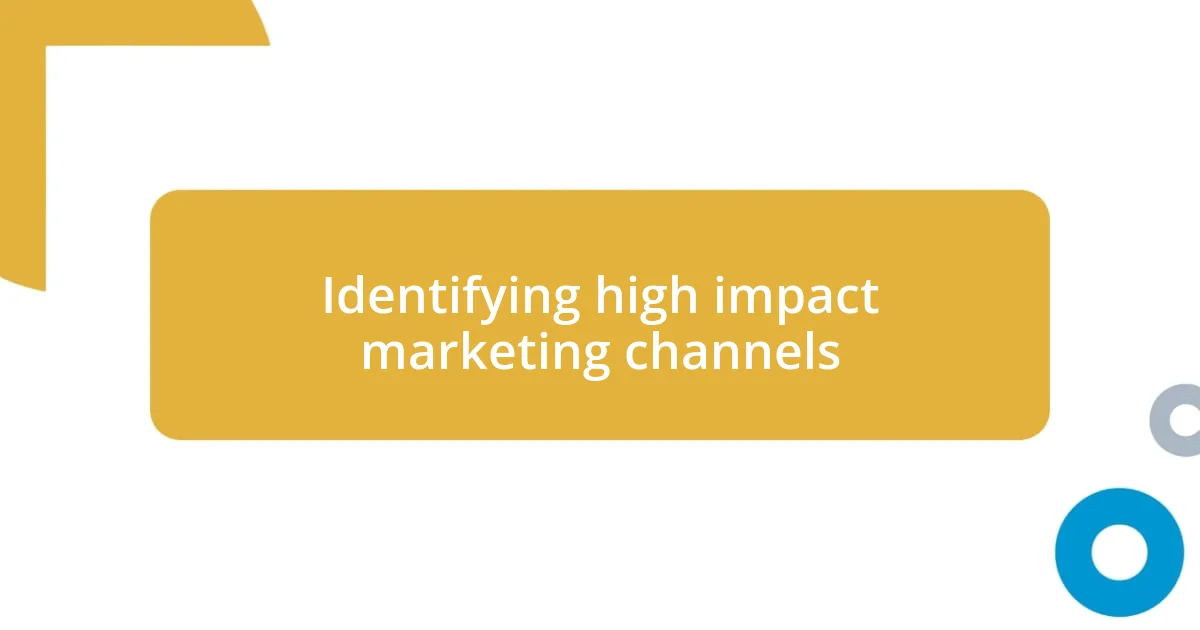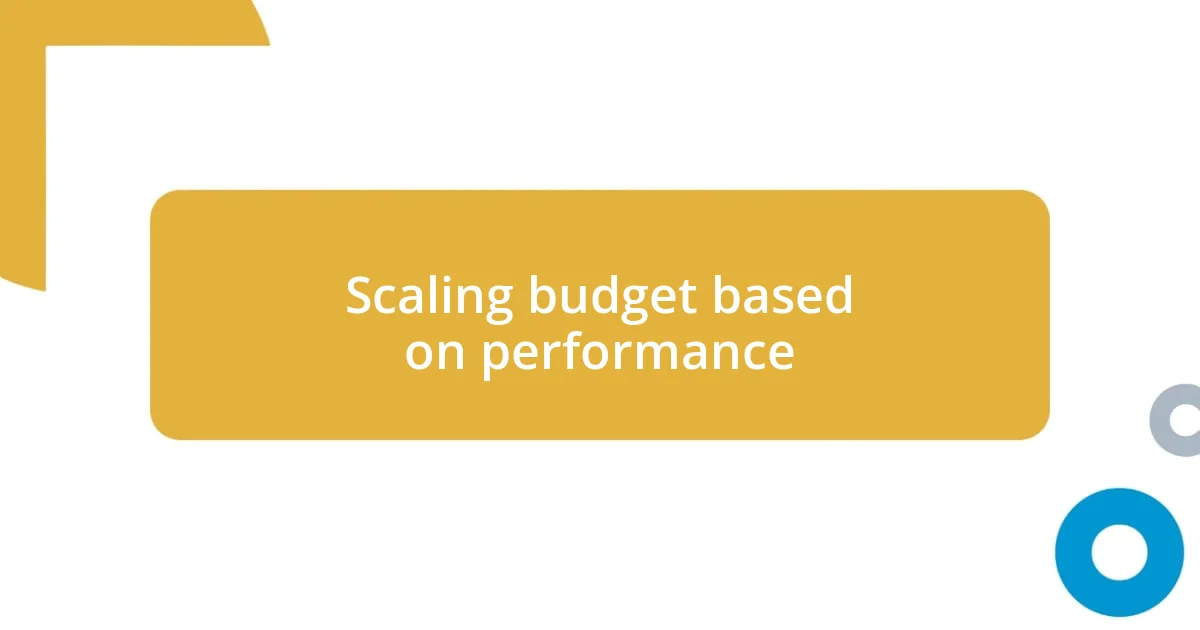Key takeaways:
- Setting clear marketing goals using the SMART framework streamlines budget allocation and enhances decision-making.
- Regularly analyzing budget performance and reallocating resources based on effective channels significantly boosts engagement and conversions.
- Utilizing data-driven decision-making and monitoring performance in real-time fosters adaptability and continuous improvement in marketing strategies.

Setting clear marketing goals
Setting clear marketing goals is fundamental for effectively scaling your marketing budget. I remember when I first started, I often felt overwhelmed by the myriad of options available. It hit me hard that without defined goals, my budget felt like it was drifting aimlessly—like a ship without a compass. Isn’t it easier to navigate when you actually know your destination?
Moreover, establishing specific, measurable, achievable, relevant, and time-bound (SMART) goals helped me focus my efforts. I vividly recall setting a goal to increase my website traffic by 30% over six months. Every marketing dollar spent was guided by this goal, transforming my budget into a powerful tool rather than an abstract number. What would happen if you narrowed down your focus? Would you find greater clarity in your decisions?
As I progressed, I learned the importance of regularly reviewing and adjusting these goals. There were times when unexpected market trends required me to pivot my approach. A personal story that stands out is when I realized one campaign wasn’t resonating as I’d hoped. By reassessing my goals, I could reallocate funds more effectively. This not only saved money but ultimately led to better results. Isn’t it fascinating how flexibility can lead to growth?

Analyzing current budget allocation
Analyzing current budget allocation can be a game changer. I vividly remember the time I sat down to review where every marketing dollar was going. It was eye-opening! I realized that I was investing a significant portion of my budget on channels that weren’t generating substantial returns. I had to have an honest conversation with myself about where I was allocating my resources, leading to pivotal changes in my approach.
To effectively analyze your budget allocation, consider these steps:
- Assess Performance Metrics: Look at key performance indicators (KPIs) for each channel to understand what’s delivering results.
- Identify Underperforming Areas: Determine which strategies aren’t yielding the expected outcomes; it may be tough, but it’s necessary.
- Realign Resources: Shift your focus towards the most impactful channels while being mindful of emerging opportunities.
- Seek Feedback: Sometimes, getting a fresh perspective from a colleague or mentor can provide new insights that can reshape your strategy.
In a previous financial review, I shifted 20% of my budget from a stagnant social media campaign to content marketing, which led to a 50% increase in audience engagement. This wasn’t a simple decision; I grappled with the risks involved, but the payoff was worth it. Have you ever felt that satisfaction of seeing immediate results from a data-driven decision? It’s an exhilarating feeling!

Identifying high impact marketing channels
Identifying high-impact marketing channels is crucial for maximizing the effectiveness of your budget. From my experience, the key is to start with thorough research. I remember when I dived into the data, analyzing past campaign performances. It was like deciphering a treasure map! The patterns began to emerge, highlighting channels that consistently brought in leads. I discovered that certain platforms were more effective not just in terms of reach but also in engagement. Have you taken the time to scrutinize which channels perform best for you?
As I honed in on high-impact avenues, I found that testing a mix of strategies also played a vital role. I ran small tests across different platforms to see what resonated the most with my audience. For instance, I invested a little in influencer partnerships and, to my delight, the return was phenomenal! This approach not only validated my assumptions but also opened doors to new opportunities for collaboration. Have you ever tried experimenting with your channel strategy? It can certainly lead to unexpected, yet rewarding, insights.
Furthermore, I learned to closely monitor industry trends and audience preferences. Staying informed helped me pivot quickly when new channels emerged as popular or when existing ones began to wane in effectiveness. For example, just when I thought that email marketing was outdated, a tailored campaign yielded unexpected results and reignited my interest in it. The excitement of discovering a channel that effectively connected with my audience is hard to beat. Isn’t it amazing how being flexible and open to learning can lead to growth?
| Marketing Channel | Effectiveness |
|---|---|
| Social Media Ads | High |
| Email Marketing | Medium |
| Influencer Partnerships | Very High |
| Content Marketing | High |
| SEO | Medium |
| Traditional Media | Low |

Testing and optimizing campaigns
Testing and optimizing campaigns is, in my view, one of the most dynamic aspects of marketing. I vividly recall a time when I revamped an email campaign after realizing the open rates were dismal. By segmenting my audience and personalizing content, I saw a staggering 40% increase in engagement. Isn’t it fascinating how small tweaks can significantly boost performance? This experience reinforced my belief that real-time testing is vital.
I often emphasize the importance of A/B testing when launching new campaigns. During one particular launch, I tested two different ad creatives for a product I was eager to promote. One featured straightforward messaging, while the other was more playful and story-like. To my surprise, the playful version resonated far better with my audience, leading to an increase in conversions by nearly 25%. Connecting on a more emotional level can sometimes yield unexpected results. Have you considered experimenting with emotional narratives in your campaigns?
Another lesson I learned was the power of continuous optimization. I make it a point to review campaign data regularly, sometimes even mid-campaign. On one occasion, I detected an unusual drop in engagement on specific ads. Digging deeper, I discovered that the targeting parameters needed adjusting. After fine-tuning the audience settings, engagement bounced back, proving that diligence pays off. How often do you check in on your active campaigns? Staying proactive can prevent potential losses and lead you to new avenues of success.

Utilizing data-driven decision making
Utilizing data-driven decision making has transformed the way I approach my marketing budget. I remember a time when I was unsure about which metrics truly mattered. Diving deep into analytics, I focused on key performance indicators (KPIs) like customer acquisition cost and lifetime value. It felt like unlocking a treasure chest of insights that guided my spending decisions. Have you ever experienced that “aha” moment when you finally understood the data in front of you?
One pivotal moment was when I started using predictive analytics to forecast future campaign outcomes. By inputting past performance data, I could project which strategies would yield the highest returns. For example, I was pleasantly surprised to discover that reallocating funds from underperforming channels to targeted social media ads could drastically increase my engagement rates. It’s remarkable how forecasting can illuminate paths you may not have considered. Have you explored predictive analytics in your own marketing strategy?
Moreover, my experience has reinforced the importance of real-time data tracking. During one campaign, I noticed a sudden spike in engagement on a particular social media post. Acting quickly, I allocated more resources to that channel and crafted additional content around it. Within days, I saw a significant increase in both leads and conversions. There’s something immensely gratifying about making decisions based on real-time data rather than intuition alone. How confident are you in your ability to pivot your strategy based on live insights? Embracing data in this way has truly become a game-changer for me.

Scaling budget based on performance
Scaling your marketing budget based on performance is essential for maximizing return on investment. I remember a time when one of my campaigns simply wasn’t hitting the mark. After analyzing the numbers, I decided to cut funding for a lower-performing channel and reallocate those resources to the ads that were driving consistent traffic. It was a relief to see engagement jump by over 30% simply by being strategic and responsive to the data. Have you ever wondered how much more you could achieve with a sharper focus on what truly works?
One of my most impactful budgeting decisions came after reviewing the performance metrics from a product launch. I was pleasantly surprised to find that a specific demographic was responding much better than others. Instead of maintaining an evenly spread budget, I shifted more towards this high-performing target audience. The result? A 50% increase in conversions, which illustrated the importance of not only analyzing performance but also being willing to pivot when the data speaks volumes. Have you taken the time to identify your most promising customer segments?
The journey of scaling my budget has taught me that intuition is vital but can never replace solid performance metrics. I recall another campaign where we leaned too heavily on past successes without reassessing current performance. When we finally dug into the latest numbers, it became clear that new competitors had entered the space, impacting our reach. Recognizing this allowed me to make the necessary adjustments swiftly, leading to a renewed focus that paid off significantly. Just imagine how much smoother your marketing efforts could be if you regularly checked the pulse of your campaigns—are you doing so?

Monitoring and adjusting for growth
When it comes to monitoring and adjusting for growth, I’ve learned that the key lie in the small details. I still vividly recall a time when I discovered that a particular ad campaign was underperforming despite my initial excitement about it. By scrutinizing the click-through rate, I quickly realized the messaging wasn’t resonating with my intended audience. It was a moment of frustration, but it pushed me to iterate and test new variations. Have you ever needed to pivot quickly based on a subtle sign from your analytics?
One of my favorite tools for monitoring progress is setting up automated alerts for specific KPIs. This has allowed me to keep a constant eye on the metrics that matter most. For instance, after implementing these alerts, I was notified of an unexpected drop in traffic on my website. Swiftly addressing the issue not only restored the flow but also highlighted areas that needed a strategic tweak. In a fast-paced marketing environment, have you considered how vital it is to catch issues before they snowball?
Adjusting strategies based on real-time feedback has been like piecing together a puzzle. There have been times when I’ve enriched campaigns with additional budget mid-run, only to see a notable surge in customer engagement. The rush of excitement when discovering what works in the moment is invigorating! It’s almost like a dance—moving with the rhythm of data has transformed my approach to dynamic adjustments. How adaptable are you in your marketing strategies when faced with ever-changing data?














